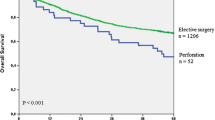Summary
The management of patients with perforation of the colon in association with cancer of the colon presents a unique and difficult surgical problem. Surgical care of the perforation and its resultant peritonitis or abscess must take precedence over that of the cancer.
In this study of 45 patients with the combined lesions, perforation occurred at the site of the tumor in 32. Ten patients were managed by primary resection with a mortality rate of 30%; 16 were managed by colostomy and drainage or a bypass procedure with a mortality rate of 50%. Six patients were moribund on admission and died before any operation could be performed. While the mortality rate would indicate that primary resection is superior to less radical forms of management, it must be recognized that those patients selected for resection were generally in better condition than the others. Therefore, mortality figures alone do not resolve the problem.
Perforation occurred proximal to the tumor in 12 patients, ten of whom underwent an operative procedure. Exteriorization or resection was used in four patients, and one died. Cecostomy or closure of the perforation was used in six patients, and of these, there were four deaths. Exteriorization or resection appear to offer better results.
The gravity of the combination of perforation and cancer of the colon and the poor long-term survival rates, combined with the apparently better results of a more radical approach, suggest that immediate resection should be considered more often and should be the object of a carefully controlled clinical study.
Similar content being viewed by others
References
Donaldson, G. A.: The management of perforative carcinoma of the colon. New England J. Med.258: 201, 1958.
Floyd, C. E., C. T. Stirling, and I. Cohn, Jr.: Cancer of the colon, rectum and anus: Review of 1,687 cases. Ann. Surg.163: 829, 1966.
Goligher, J. C. and F. G. Smiddy: The treatment of acute obstruction or perforation with carcinoma of the colon and rectum. Brit. J. Surg.45: 270, 1957.
Gregg, R. O.: The place of emergency resection in the management of obstructing and perforating lesions of the colon. Surgery.37: 754, 1955.
Lichtenstein, M. E., W. H. Myers, and G. F. Dwyer, Jr.: Perforation of the cecum from obstructing carcinoma of the distal colon. Am. J. Surg.101: 26, 1961.
Madden, J. L.: Primary resection and anastomosis in the treatment of perforated lesions of the colon. Am. Surgeon.31: 781, 1965.
Mersheimer, W. L. and E. M. Miller: Diffuse peritonitis secondary to intestinal perforation complicating malignant lesions of the colon. Surg., Gynec. & Obst.99: 436, 1954.
Russell, I. and N. Johnson: Perforation of the colon in large bowel obstruction due to carcinoma. Australian & New Zealand J. Surg.29: 332, 1960.
Author information
Authors and Affiliations
Additional information
Read at the meeting of the American Proctologic Society, New Orleans, Louisiana, April 17 to 19, 1967.
Supported in part by grant #AI 01600 from the National Institute of Allergy and Infectious Diseases, National Institutes of Health, U.S. Public Health Service.
About this article
Cite this article
Crowder, V.H., Cohn, I. Perforation in cancer of the colon and rectum. Dis Colon Rectum 10, 415–420 (1967). https://doi.org/10.1007/BF02616812
Issue Date:
DOI: https://doi.org/10.1007/BF02616812




